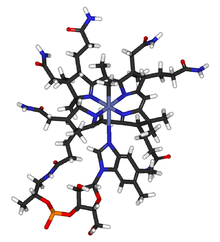- Methylcobalamin
-
Methylcobalamin 

Systematic (IUPAC) name carbanide; cobalt(3+); Clinical data AHFS/Drugs.com International Drug Names Pregnancy cat. ? Legal status ? Routes oral,sublingual,injection. Identifiers CAS number 13422-55-4 
ATC code B03BA05 PubChem CID 6436232 UNII BR1SN1JS2W 
ChEMBL CHEMBL1697757 
Chemical data Formula C63H91CoN13O14P Mol. mass 1344.40 g/mol  (what is this?) (verify)
(what is this?) (verify)Methylcobalamin is a cobalamin (MeCbl or MeB12) used in the treatment of peripheral neuropathy, diabetic neuropathy, and as a preliminary treatment for amyotrophic lateral sclerosis. It is a form of vitamin B12 and differs from cyanocobalamin in that the cyanide is replaced by a methyl group.[1] Methylcobalamin features an octahedral cobalt(III) centre.
This vitamer is one of two active coenzymes used by vitamin B12-dependent enzymes and is the specific vitamin B12 form used by 5-methyltetrahydrofolate-homocysteine methyltransferase (MTR), also known as methionine synthase. Methylcobalamin is notable for being one of the few examples in nature of a bona fide organometallic bond, although Ni-CH3 intermediates are proposed for the final step of methanogenesis. In physiological terms, it is equivalent to vitamin B12, e.g. for addressing pathologies arising from a lack of vitamin vitamin B12, such as pernicious anemia.
Contents
Functions
Role in biomethylation
Methylcobalamin plays an important role in the environment. It is produced preferentially by some bacteria. In the environment, it is responsible for the biomethylation of certain heavy metals. For example, the highly toxic methylmercury is produced in this way.[2] In this role, methylcobalamin serves as a source "CH3+". In the Wood-Ljungdahl pathway, methylcobalamin provides the methyl group that couples to carbon monoxide to afford acetyl-CoA.[3]
Small clinical studies
Methylcobalamin has been studied in conjunction with sleep-wake rhythm disorders, where it appears to yield benefits, but at a low or inconsistent level.[4]
Supplementation with megadoses of methylcobalamin has been advocated to protect the cognitive function of patients suffering chronic fatigue syndrome, stroke, depression, Alzheimers disease, and other neurological diseases. The rationale is that methylcobalamin may help to remove brain-damaging levels of the neurotransmitter glutamate. Methylcobalamin has been reported to have been used to reduce neurotoxicity and lower excess glutamate levels, resulting in the reduction of fatigue, stabilisation of mood, improvement of memory, and executive function. However, clinical trials using methylcobalamin have been small and, for the most part, have not been replicated or confirmed.[5]
See also
References
- ^ L. R. McDowell, Vitamins in animal and human nutrition, http://books.google.co.uk/books?id=dXOPBMYIPcQC&pg=PA526
- ^ Zenon Schneider, Andrzej Stroiński, Comprehensive B12: Chemistry, Biochemistry, Nutrition, Ecology, Medicine, http://books.google.co.uk/books?id=OBlxCKbYCx8C&pg=PA32
- ^ J. C. Fontecilla-Camps, Patricia Amara, Christine Cavazza, Yvain Nicolet, Anne Volbeda
- ^ Double-blind test on the efficacy of methylcobalamin on sleep-wake rhythm disorders
- ^ [1]
Vitamins (A11) Fat soluble D2 (Ergosterol, Ergocalciferol#) · D3 (7-Dehydrocholesterol, Previtamin D3, Cholecalciferol, 25-hydroxycholecalciferol, Calcitriol (1,25-dihydroxycholecalciferol), Calcitroic acid) · D4 (Dihydroergocalciferol) · D5 · D analogues (Dihydrotachysterol, Calcipotriol, Tacalcitol, Paricalcitol)Water soluble B1 (Thiamine#) · B2 (Riboflavin#) · B3 (Niacin, Nicotinamide#) · B5 (Pantothenic acid, Dexpanthenol, Pantethine) · B6 (Pyridoxine#, Pyridoxal phosphate, Pyridoxamine) · B7 (Biotin) · B9 (Folic acid, Dihydrofolic acid, Folinic acid) · B12 (Cyanocobalamin, Hydroxocobalamin, Methylcobalamin, Cobamamide) · CholineCombinations M: NUT
cof, enz, met
noco, nuvi, sysi/epon, met
drug(A8/11/12)
Enzyme cofactors Active forms TPP / ThDP (B1) · FMN, FAD (B2) · NAD+, NADH, NADP+, NADPH (B3) · Coenzyme A (B5) · PLP / P5P (B6) · Biotin (B7) · THFA / H4FA, DHFA / H2FA, MTHF (B9) · AdoCbl, MeCbl (B12) · Ascorbic Acid (C) · Phylloquinone (K1), Menaquinone (K2) · Coenzyme F420ATP · CTP · SAMe · PAPS · GSH · Coenzyme B · Cofactor F430 · Coenzyme M · Coenzyme Q · Heme / Haem (A, B, C, O) · Lipoic Acid · Methanofuran · Molybdopterin/Molybdenum cofactor · PQQ · THB / BH4 · THMPT / H4MPTBase forms M: NUT
cof, enz, met
noco, nuvi, sysi/epon, met
drug(A8/11/12)

This drug article relating to the gastrointestinal system is a stub. You can help Wikipedia by expanding it. This drug article relating to the blood and blood forming organs is a stub. You can help Wikipedia by expanding it.
